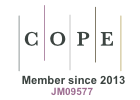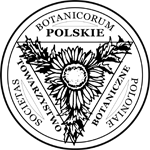Mycological analysis of air in selected rooms of the University of Szczecin – a pilot project
Abstract
Keywords
Full Text:
PDFReferences
Nowakowicz-Dębek B, Krukowski H, Wlazło Ł, Bojarczyk M. Ocena mikologiczna powietrza w domach zalanych w czasie powodzi na przykładzie gminy Wilków. / Mycological assessment of air in homes flooded during the flood on the example of the Wilków commune. Mikologia Lekarska. 2011; 18(2): 87–89. (in Polish)
Żukiewicz-Sobczak W, Sobczak P, Imbor K. et al. Zagrożenia grzybowe w budynkach i w mieszkaniach – wpływ na organizm człowieka. / Fungal hazards in buildings and flats – impact on the human organizm. Medycyna Ogólna i Nauki o Zdrowiu. 2012; 8(2): 141–146. (in Polish)
Lacey J. Spore dispersal – its role in ecology and disease: the British contribution to fungal aerobiology. Mycological research. 1996; 100: 641–660.
Fitt BDL, Huang YJ, van den Bosch F, West JS. Coexistence of related pathogen species on arable crops in space and time. Annu. Rev. Phytopathol. 2006; 44: 163–182.
Jackson FA. Didymella. In: Jensen K, Gravesen S. Atlas of moulds in Europe. ASK Publishing; 1984. p. 30.
Barnett HL, Hunter BB. Illustrated genera of imperfect fungi. Minneapolis: Burgess Publishing Company; 1972.
Lipiec A, Rapiejko P. Alternaria alternata – aerobiologia, charakterystyka alergenów i aspekt kliniczny. / Alternaria alternata – aerobiology, allergens’ characteristics and clinical aspect. Alergia. 2005; 2(24): 39–42. (in Polish)
Stryjakowska-Sekulska M, Piotraszewska-Pająk A, Filipiak M. Outdoor and indoor fungal microflora of academic buildings in Poznań. In: AEROTOP. Fungal Spore Workshop. Poznań. 8–10 April 2005; 34–43.
Grinn-Gofroń A. Rodzaj Ganoderma jako źródło potencjalnych alergenów grzybowych. Alergoprofil. / Ganoderma genius as a source of potential mould’s allergens. 2008; 4(1): 40–43. (in Polish)
Krajewska-Kułak E, Łukaszczuk C, Gniadek A, et al. Porównanie wyników badań zanieczyszczenia powietrza grzybami pomieszczeń oddziału opieki długoterminowej z wykorzystaniem aparatów SAS SUPER 100 i AIR IDEAL. / Comparison of results of the fungal air pollution in the long-term care departments using SAS SUPER 100 and AIR IDEAL samplers. Mikologia Lekarska. 2010; 17: 221–227. (in Polish)
Khan H, Karuppayail M. Practices contributing to biotic in Air-conditioned indoor environments. Aerobiologia. 2011; 27: 85–89.
Tendal K, Madsen AM. Exposure to airborne microorganisms, hyphal fragments, and pollen in a field of organically grown strawberries. Aerobiologia. 2011; 27: 13–23.
Kiziewicz B, Zdrojkowska E, Rogoz N. Analiza stężenia zarodników grzybów potencjalnie chorobotwórczych w powietrzu samochodów klimatyzowanych i bez klimatyzacji w Białymstoku. / The analysis of Aspergillus spore count in indoor air of academic buildings Medical University in Bialystok in 2012. Alergoprofil. 2012; 2: 13–17. (in Polish)
Puc M, Kotrych D. Zarodniki grzybów w powietrzu budynku Archiwum Miejskiego w Świnoujściu. / Fungi spores in the air of the building of the Municipal Archive in Świnoujście. Alergoprofil. 2012; 8(3): 32–36. (in Polish)
Górny RL, Cyprowski M, Ławniczek-Wałczyk A, Gołofit-Szymczak M, Zapór L. Biohazards in the indoor environment – a role for threshold limit values in exposure assessment. In: Dudzińska MR, editor. Management of indoor air quality. London: Taylor and Francis Group; 2011. p. 1–20.
Rapiejko P, Stankiewicz W, Szczygielski K, Jurkiewicz D. Progowe stężenie pyłku roślin niezbędne do wywołania objawów alergicznych. / Threshold pollen count necessary to evoke allergic symptoms. Otolaryngologia Polska. 2007; LXI(4): 591–594. (in Polish)
D’Amato G. Spieksma FThM. Aerobiologic and clinical aspects of mould allergy in Europe. Allergy. 1995; 50: 870–877.
O’Connor GT. Airborne fungi in the homes of children with asthma in low-income urban communities: The inner-City Asthma Study. J Allergy Clin Immunol. 2004; 114(3): 599–606.
Reynolds SJ, Black DW, Borin SS, Breuer G, Burmeister LF, Fuortes LJ, et al. Indoor environmental quality in six commercial office buildings in the Midwest United States. Appl. Occupational Environ. Hygiene. 2001; 16: 1065–1077.
Brickus LSR, Siquiera LFG, Aquino Neto FR, Cardoso JN. Occurrence of airborne bacteria and fungi in bayside offices in Rio de Janeiro, Brazil. Indoor Built Environ. 1998; 7: 270–275.
Hussein HS, Brasel JM. Toxicity, metabolism, and impact of mycotoxins on humans and animals. Toxicology. 2001; 167: 101–134.
Miklaszewska B, Grajewski J. Patogenne i alergogenne grzyby pleśniowe w otoczeniu człowieka. / Pathogenic and allergic moulds in humans environment. Alergia. 2005; 2(24): 45–50. (in Polish)
Stern MA, Allitt U, Corden J, Millington J. The investigation of fungal spores in intramural air using a Burkard continuous recording air sampler. Indoor built Environ. 1999; 8: 40–48.
Corden JM, Millington WM. The long-term trends and seasonal variation of the aeroallergen Alternaria in Derby, UK. Aerobiologia. 2001; 17: 127–136.
Levetin E, Horner WE. Fungal Aerobiology: Exposure and Measurement. In: Fungal Allergy and Pathogenicity. Chem Immunol. Basel, Karger. 2002; 81: 10–27.
Krzysztofik B. Mikrobiologia powietrza. Warszawa: Wydawnictwo Politechniki Warszawskiej; 1992. p. 19–20. (in Polish)
Helbing A, Reimers A. Immunotherapy in fungal allergy. Curr. Allergy Asthma Rep. 2003; 3: 447–453.
Kurnatowska A. Biologia i ekologia grzybów chorobotwórczych. [In:] Baran E, editor. Zarys mikologii lekarskiej. Wrocław: Volumed; 1998. p. 21–37. (in Polish)
DOI: https://doi.org/10.5586/aa.2014.024
|
|
|






